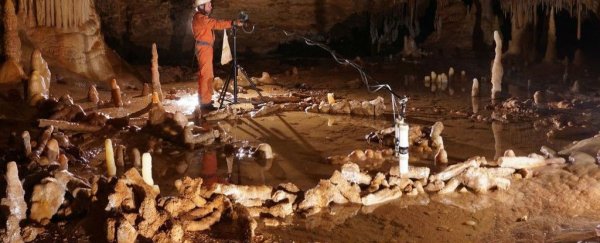Turns out we know a whole lot less about Neanderthals than we thought, because our cave-painting, tool-wielding, fire-conquering cousins were sophisticated enough to build complex subterranean structures as far back as 176,500 years ago, according to new archaeological evidence.
Deep inside a dark, underground cave 50 km from the city of Toulouse, France, researchers have uncovered the remains of six ancient structures crafted from stalagmites. The find forces us to rethink our assumptions about these archaic humans, because what they appear to have built is far beyond anything we thought they were capable of.
"Neanderthals were inventive, creative, subtle and complex," one of the team, Jacques Jaubert from France's Bordeaux University, told AFP. "They were not mere brutes focused on chipping away at flint tools or killing bison for food."
The ring-shaped structures were found 300 metres deep inside Bruniquel Cave in southwest France, and one is thought to have stood almost 7 metres wide. The twisted corridors of this cave are pitch black this far from the entrance, so the Neanderthals would have had to construct everything by firelight.
Jaubert and his team uncovered around 400 stalagmite pillars that together would weigh about 2,000 kilograms and stretch 112.4 metres. All of this suggests that they figured out how to work as a team to construct complex buildings in a difficult conditions.
"What surprises us most is the ability of Neanderthals to have explored very deep into caves … far from natural light," says Jaubert.
"We believe we are providing evidence of the capacity of Neanderthals to enter a hostile, underground environment, using fire to light the way, to do things that go beyond mere survival."
Dated to between 174,400 to 178,600 years ago, the researchers say this is evidence that Neanderthals were constructing buildings tens of thousands of years before the first Homo sapiens arrived in Europe.
At this stage, what isn't exactly clear is why this community appears to have banded together to achieve this complex, difficult task in an inhospitable environment. If they needed shelter from the elements and protection from predators, they were already inside a deep cave, why go to all the trouble of building a structure within a structure?
The obvious answer is these structures served some kind of religious or ceremonial purpose for the Neanderthals, but as with much in archaeology, we can only confirm what the physical evidence shows us, and right now, there's nothing to back that up.
"The big question is why they made it," Jean-Jacques Hublin, a palaeoanthropologist at the Max Planck Institute for Evolutionary Anthropology in Germany who was not involved in the study, told Ewen Callaway from Nature. "Some people will come up with interpretations of ritual or religion or symbolism. Why not? But how to prove it?"
Others aren't even convinced by the evidence we do have that we should be calling them human-made at all.
"To me, constructing some sort of structure - things a lot of animals do, including chimps - and equating that with modern cultural behaviour is quite a leap," Harold Dibble, an archaeologist at the University of Pennsylvania, told Nature.
A more convincing argument, he said, would be if all 400 stalagmite pillars were more or less uniform in size and shape, further emphasising the conscious thought involved in piecing them all together.
Still, with some healthy skepticism in mind, we're still allowed to be excited, because whatever these structures were, we've never seen anything quite like them on Earth.
"These structures are among the best-preserved constructions known for the whole of the Pleistocene epoch, probably because they were sealed by calcite very soon after they were erected," Marie Soressi, an archaeologist at the Leiden University in the Netherlands, who was not involved in the find, wrote in a commentary in Nature.
"When the best evidence is found in the best-preserved context, it serves as a reminder for archaeologists of how much we depend on preservation."
The find has been described in the journal Nature.
